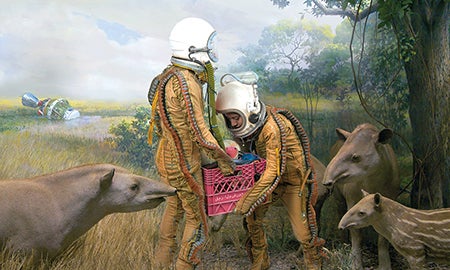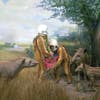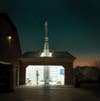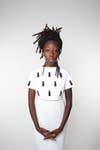Former Photo Interns on Going Pro
Six years ago, Daniel McKee and Lilian Martinez worked as interns for Todd Baxter Photography when it was based in...








Six years ago, Daniel McKee and Lilian Martinez worked as interns for Todd Baxter Photography when it was based in Chicago. Baxter and his wife and creative partner, Aubrey Videtto, moved to Los Angeles in 2013. This year their former interns also moved to L.A. to found Ola Onda, with the two partners sharing photographic and management duties. Here the four friends discuss the daunting but exciting process of starting up a new studio.
Daniel McKee (Ola Onda): When did you realize you could, and needed to, bring in interns?
Todd Baxter (Todd Baxter Photography): When I started out, I had a handful of friends who also had their own small creative businesses and who had interns. I also remembered my own experience interning as an undergrad. I worked with an artist who was painting out of his home. I really learned a lot seeing an artist outside of the classroom, doing the things an artist does to make a living. When I switched from agency work (design and art direction) to running a photography business, I jumped at the chance to work with student interns who wanted experience working with a professional photographer. I realized it was useful for students to see how to run a startup. My initial shock about running a photo business was how little time is spent taking pictures. There are so many other aspects: estimates, marketing, bookkeeping, et cetera. Working with interns always ends up being a learning experience for me as much as it is for them.
Aubrey Videtto (Todd Baxter Photography): When I started working with Todd, one of the first things I noticed was how important the student interns were to the energy of our workflow and how we continued to grow as professionals through our interactions with them. Explaining and teaching are valuable ways to constantly question our own assumptions. And the interns never cease to amaze us in the innovative ways they solve problems.
Lilian Martinez (Ola Onda): We still build on a lot of the things we learned when we interned with you. What are some of the things you’ve learned from your mentors that you still use?
Baxter: Though I did study photography, along with other fine-art media, I hadn’t studied to become a commercial photographer. I missed the chance to work or learn under commercial pros. That meant I had to fumble through learning the business side of things early on, but it also kept my artistic vision steady, since I continued to focus on the detail-oriented aesthetic I developed in art school. I do carry things I learned from other people—art teachers, professors, mentor artists, and creative peers. One of the important things I learned was how to keep creating in a world full of creative obstacles: time, money, family, self-doubt.
Videtto: I studied both creative writing and photography—my emphasis was always on storytelling. And thinking through the story behind a lot of the work we do is a vital process. With a commercial assignment, the story is the “concept” the client has commissioned us to bring to life. We’re often brainstorming ways to take that story to the next level by considering how all the details of an image can contribute to a rich and engaging story. I often fall back on the storytelling techniques I learned from mentors and other writers to help my audience connect with and invest in a story.
McKee: What were some of the steps you took to gain your first commercial clients?
Baxter: I moved to Chicago and began working as a designer at an advertising agency. I did a lot of in-house photography. When the first digital Canon Rebel came out, I tried to talk the agency into buying one and a lighting kit to set up an in-house studio. They didn’t go for it. So I bought the setup for myself, and shortly after that, I left the agency. I started making work to build up a portfolio. During that time I worked freelance as a designer for ad agencies. I had friends at various agencies who knew I was starting up my own photo business. Thanks to those relationships, I was able to land some small photo jobs, and it built up from there.
McKee: As a photographer, one of my goals is to have a studio outside our living space. But more recently I feel that the work-from-home model has become a key tool for helping photo businesses cut overhead costs. What are your thoughts?
Baxter: I agree. I’ve always wanted a sweet big-ass studio with cool concrete floors, giant windows with a view of downtown, super-tall ceilings so I could fly drones around. When I started out there were a number of established photographers who had these huge studios. Some still do. But for a lot of photographers, big studios become financial burdens when the industry or economy shifts. For me, it makes more financial sense to rent a studio when I get a job—one appropriate to the scale of the work we’re doing and the budget. I sometimes rent gear. The at-home workspace can be minimal—a bonus room or garage. Aubrey and I have been known to haul the furniture out of the biggest room of our home to turn it into a temporary studio.
Martinez: What do you look for when you choose a team of creatives to help achieve your vision?
Baxter: For us, the key creative players are the lead stylists (often we have a wardrobe stylist and a set/props stylist) and the lead hair and make-up artist. We generally choose stylists whose style and skills best fit the project. You can get a good idea about this by looking at their portfolios, but you need to work together on a job to see how the two of you will click. Generally speaking, we gravitate toward people who are hard-working and friendly, who know their craft, and are creative people themselves. Recommendations from people you trust are helpful, too.
McKee: How did you come to develop your aesthetic as we know it now? How have you seen it change through the years?
Baxter: My mom painted a lot when we were growing up, encouraged us to draw and paint, and took us to a lot of art museums. So I had art imprinted on my brain at an early age. In high school I got into art full-force—surrealism, Dada, and pop art. I had a couple of great teachers.
In undergrad [at the University of New Mexico], I met a grad student who did these amazing small paintings. He would select, cut, and paste photo elements from 1950s-era books onto gessoed panels, and using oil paint, he would paint all of the photo elements to create a single image that existed somewhere between photography and realist painting. This work had a great impact on my aesthetic. My work today feels like a similar process—but instead of photos cut from old books woven together with oil paint, I take photo elements with my DSLR and weave them together in Adobe Photoshop.
Martinez: How do you feel Aubrey’s coming into the business has influenced your work?
Baxter: Aubrey’s photo background was more focused on photojournalism than fine art, so my process is much different. I work very intuitively. But when I get stuck, I’ll ask Aubrey to bounce ideas around with me. We talk through the image, what it’s wanting to be—what helps that and what doesn’t. She helps to focus and develop the potential of the images. She’s very good at identifying what’s slightly off about a composition that’s keeping an image from fully coming together.
When Aubrey left her university job to work for my business, she added this effect to all aspects of the image-making process: idea generation, pre-production, production, and post-production. We work really well together during post.
Videtto: Initially, my contribution was weighted toward the business side of things, but now I’d like to think it’s more nuanced. Todd and I collaborate creatively on the commercial projects. As for his fine art, I think of myself as a helper. Sometimes that means I’m carrying a bag of lights through the woods, and sometimes I’m a second shooter capturing elements that could come in handy during his compositing.
McKee: What are your thoughts on how the industry has changed in regard to the skills a photographer should bring to different jobs?
Baxter: Historically, the industry has pushed us to specialize: underwater, kids, lifestyle, food, etc. This model works if you find a niche you enjoy and there is a steady supply of work to keep you busy. The risk is that you may limit the type of projects people will consider hiring you for. Photo budgets aren’t what they used to be, and there are a lot of pro shooters competing for the same work. A basic function of any marketing strategy for your brand should be differentiation: What can you offer? What can you do better than your competitors?
But diversifying your skill set can also mean learning and becoming skilled in web design, marketing, and business planning in order to enhance your own brand story. It can mean learning a seemingly unrelated skill to add depth to your personal work or creative process. The best thing you can do is make the work you are most passionate about. Think of it as your voice. Then learn to position your voice as a brand or product.